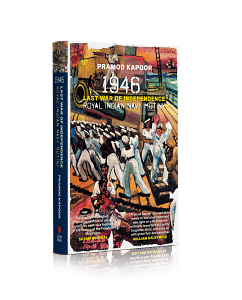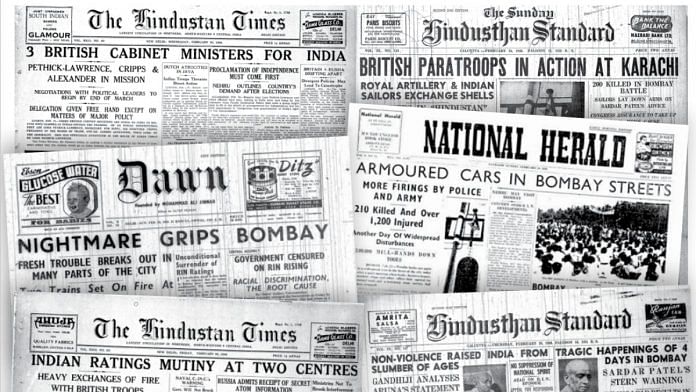Get up you sons of coolies, sons of bloody junglees, you sons of bitches.’ That torrent of abuse was hurled by Commander King at the Indian ratings under his command, and it echoed across the barracks and corridors of HMIS Talwar. The abusive outburst would ignite a smouldering tinderbox and elicit a response, which would shake the British to the core and cause panic and consternation in faraway Whitehall.
The HMIS Talwar in Bombay was a strategically important naval establishment for the British forces in India. It was the second largest signal school in all of the British Empire.
It became the platform for the launch of the naval mutiny of February 1946. There were close to 2,000 Indian naval ratings posted there, who had been subjected to the most degrading and inhuman service conditions. Their anger and frustration had reached boiling point, and it was further fuelled by stories of the nationalist movement and the heroic deeds of the INA.
The spark that lit the conflagration was supplied by the British themselves, namely, by Commander King. The British authorities made a cardinal mistake in appointing King as commander of HMIS Talwar in January 1946 – a time when emotions were running high in this important shore establishment.
In his book B.C. Dutt described King as ‘a large built man with a very small brain.’ A racist, his hatred for ‘Bloody Indians’ was displayed openly. Not only was he a racist, he was also uncomfortable with educated ratings who could talk back to him. His dismal man-management skills led to him using bullying tactics to discipline the men under his command. The result was inevitable: he became the target for the ratings to vent their frustrations and growing anger at the mistreatment and blatant discrimination.
The ratings had deflated the tyres of his car and painted nationalist slogans like ‘Quit India’ on the vehicle, making King look foolish and incompetent. He became a laughing stock within the Bombay naval establishment and, by February 1946, his hold on command was tenuous. He was getting anonymous threatening letters that put him under extreme psychological pressure until he snapped, leading to the point of no return.
Also Read: ‘Gandhi did not stop here at all’—Why people in Dandi don’t say he walked that route
Commander Arthur Frederick King, who incidentally was born on 2 October (the same as Mahatma Gandhi) 1917 will forever be remembered as the man who lit the ‘spark that kindled the fire’ of the rebellion.
King’s naval career started in 1934 when he applied for a cadetship in Royal Navy, but wasn’t selected because he failed in the written exams due to his poor proficiency in French. He had, however, passed the admiralty interview and was invited to join the Royal Indian Navy. He underwent the same training given to seamen of the Royal Navy. He was involved in a salvage operation in the mid-Atlantic in the very first week of his joining the navy and earned appreciation for this.
King’s first ship was the elderly sloop, HMIS Clive, which was operating in the Bay of Bengal searching for Japanese spies and for covert operations around the islands of the Andaman and Nicobar archipelago. He and his fellow seamen had to be disguised as pearlfishermen for this mission. During the expansion years of the RIN in 1938, King was appointed to the training ship, HMIS Dalhousie. His first group consisted of forty boys from the Punjab who had never seen the sea, let alone board a ship. He had to learn Urdu to be able to communicate with them and pass his command exams.
In 1939, King was sent to Delhi to help set up the new Navy office. The following year, in 1940, he returned to England to qualify as a gunnery specialist. In 1941, he was appointed to HMIS Jumna, a new ship being built in Dumbarton, on the north coast of the River Clyde in Scotland. King visited nearby Glasgow frequently and met his future wife Anne there. In 1942, King spent a difficult, frustrating, and often exasperating year in Imperial Delhi, living in the Delhi Gymkhana Club. In 1943, he was transferred to England as first lieutenant because he despised the office work in Delhi. In 1944, while serving in HMIS Cauvery, then aged twenty-six, King was given the ship’s command due to her captain falling sick. As captain of Cauvery he escorted convoys in the Atlantic and later hunted Japanese submarines in the Indian Ocean. His excellent record soon brought him to the commanding officer (CO) level.
Also Read: ‘Slaughtered ten by ten’: How 1857 martyrs shot by British firing squad were found in Punjab well
Commander King took charge as CO of the troubled HMIS Talwar on 21 January 1946. However, his task would be an uphill one. Taking charge as CO from Commander Cole was an onerous responsibility because Cole was hugely popular, particularly with the Indian ratings. This may have been a reason why Cole was seen as being too lenient and sympathetic towards Indians when the issue of writing anti-British slogans on the walls of HMIS Talwar became a concern.
The British wanted someone tough, and to them, King was a no-nonsense officer who would restore discipline to HMIS Talwar. King wasted no time in enforcing his authority. On 8 February, a day after his car was painted with ‘Quit India’ slogans and its tyres deflated, he decided to make a surprise visit to the naval barracks early in the morning. The ratings ignored him and did not get up or salute him.
Enraged, he shouted, ‘Get up, you sons of coolies,’ and ‘You sons of Indian bitches.’ Discontent had been simmering for some months and this abuse was the last straw. The ratings complained orally to higher authorities, but their complaint was passed back to Commander King, who ordered them to take back their complaints or face serious consequences. For a week, no action was taken.
Earlier, on 2 February, B.C. Dutt had been arrested for writing seditious slogans on the walls of Talwar. That set off a chain reaction with ratings becoming more intransigent and King trying to impose his authority in a heavy-handed fashion.

This excerpt from ‘1946 Last War of Independence’ by Pramod Kapoor has been published with the permission of Roli Books.



